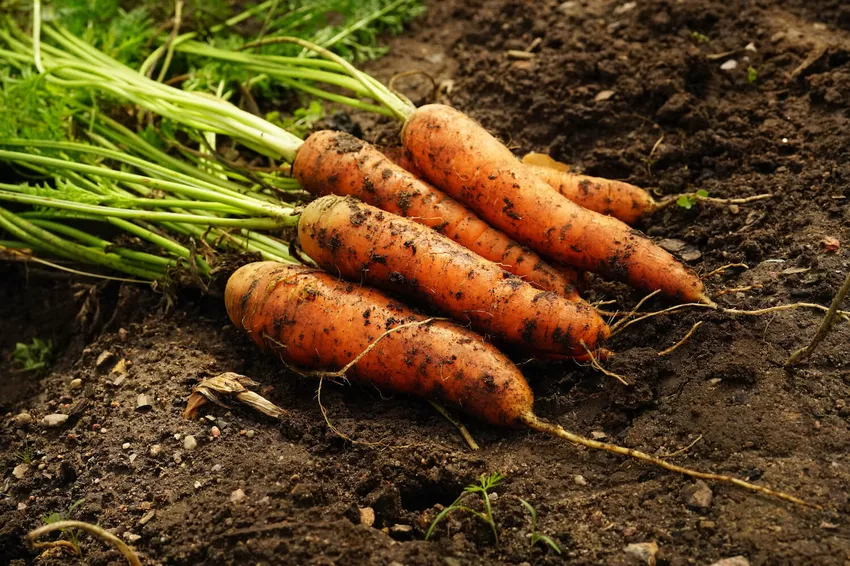The carrot is one of the most popular root vegetables and also grows in your own garden. We give tips on growing, harvesting and storing.

Whatever you want to call the popular root: The carrot, also called yellow turnip or carrot, has the scientific name Daucus carota subsp. sativus. Like the fennel, the carrot belongs to the umbelliferae family. The vegetable is particularly appreciated for its high carotene content.
Originally, the carrot probably comes from Southern Europe, North Africa or the Middle East. The popular vegetable quickly spread throughout Europe and Asia. This is not surprising as the carrot thrives in temperate to subtropical climates.
Synonyms: yellow beet, yellow beet, carrot, carrot, root, carrot (CH), carrot (engl.)
Carrot cultivation: We show you how it's done
The carrot likes it sunny to semi-shady and prefers loose soil. This is necessary for the root to form and spread freely. The plant is a classic representative of the medium-eaters. Poor soils should therefore be improved with some primarily organic long-term fertilizer or alternatively compost. Our Plantura organic tomato fertiliser, which contains all the important nutrients for a rich vegetable harvest, is excellently suited.
You can start sowing in an unheated greenhouse from the end of February. In the field you sow directly into the bed. This can be done from the end of March and theoretically into the summer. However, if you want to store carrots, you should sow them early and no later than May. Depending on the temperature, germination can take over two weeks.
Depending on the purpose, the carrots should be planted at a distance of between 3 and 6 cm. The larger the roots are to be (e.g. in the case of storage varieties), the larger the distance must be selected. The typical row spacing is 30 cm. No additional fertilizing is required during the growth phase in a well-prepared soil. However, it should be watered when it is dry.
Tip: Carrot cultivation is particularly easy with a cultivation set such as our Plantura vegetable cultivation set. It contains everything you need for delicious carrots andneed other homegrown vegetables.
Carrot Varieties
Carrots can be divided into early, summer and autumn carrots. You can also distinguish between the various colors and shapes. Because there are also purple or yellow and spherical carrots.
You can find a comprehensive overview of varieties here: Carrots: choosing the right variety for cultivation.

- Adelaide (F1): very early variety with very good taste and delicate texture; quite compact variety with smaller roots; ideal for culture on the balcony or terrace.
- Fucino: proven Italian variety with a good taste and a delicate texture.
- Nandor (F1): more compact variety with good characteristics; suitable for cultivation in flower pots on balconies and terraces.
- Paris Market: tried and tested, spherical variety with red-orange roots; one of the first varieties for hobby cultivation; very good taste and texture.
- Purple Haze (F1): exceptional appearance; deep purple peel; inside, the color goes towards orange again; good taste, high carotene content; ideal for fresh consumption and for storage.
- Rotin: very popular variety with a very high carotene content; Rotin quickly turns intense orange and has a high sugar content.
- Sugarsnax 54 (F1): very early carrot variety with high carotene content; tender and good to eat raw.
- Totem: proven, early variety with high yield and good taste; strong coloring and high carotene content.
- Yellowstone: variety that lives up to the name yellow beet; intense yellow roots with a good, fruity taste; ideal for giving one or the other dish a new coat of paint.

Harvesting and storage of carrots
In general, as already mentioned, carrots can be classified into different categories. The exact development time depends on the time of sowing and the variety.
- Early carrots: 70 to 90 days
- Summer carrots: 110 to 135 days
- Late carrots/ storage carrots: 170 to 220 days

Ingredients and Use
The carrot is known for its high carotene content. This is the highest among the vegetables, but can vary by a factor of 6 depending on the variety and type of cultivation. The red-violet to purple varieties in particular also contain anthocyanins.Carrots contain a comparatively large amount of sugar (up to 10g per 100g fresh weight) and essential oils. These also make the taste of the carrot so unmistakable.
The use of the carrot is very versatile. You can grate the root raw into a salad, eat it pure or juice it. Steamed or fried, it can be served as an accompaniment to hearty dishes or it finds its way into the dish as a soup or roast vegetable.

Pests and Diseases
Carrots can be grown well in your own garden even without pesticides. Feeding by rodents such as voles can often occur. In addition to these pests, the carrot fly is particularly worth mentioning. It is important that the roots are always covered with soil and that the plant is not injured when weeding or hoeing. Because then the smell attracts the carrot fly. With nets and fleece you can give the plants a natural protective shield against the pest.